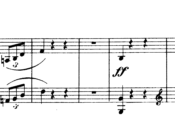Analysis
Contents
- 1 Analysis
Presto Con Fuoco
Form: Scherzo. B Minor.
SECTION A: B minor, very dramatic and agitated, in an extended ternary (ABABA) form.
Bars 1-8: Introduction. Two loud, arresting chords, inversions of ii half diminished seventh, and the dominant seventh.
A:
Bars 9-44: The main theme is heard in B minor with tonic pedal in the bass (Bars 9-16) then E minor with dominant pedal in the bass (Bars 17-24).
The passage which follows is all in B minor, with a dominant pedal in Bars 25-36, frequent diminished seventh chords (e.g. Bars 29-32, 37, 39, 41, 44), and some chromatic unessential notes (e.g. E sharp in Bar 27, G sharp in Bar 29) but no modulation.
Bars 44-68: Interlude, softer, with occasional loud outbursts, all in B minor, ending with a perfect cadence in Bars 66-67.
B:
Bars 69-124: Agitato. Begins with a sequence based on the rhythm and figurations of the main theme, using the chord progression iv-V7-I in D major (Bars 69-72), F sharp minor (Bars 73-76), and A major (Bars 77-79).
Followed by another sequence, using a French augmented sixth and dominant chords of C sharp minor (Bars 80-81), C minor (Bars 82-83) and B minor (Bars 84-85).
Bars 86-101 are in F sharp major (dominant major) with a flattened sixth (D natural), with perfect cadences in Bars 92-93 and 100-101.
Returns to B minor in Bars 1101-109, with a dominant pedal and some chromaticism, ending on a dominant ninth chord in Bar 109. The remaining bars (Bars 110-124) are based on diminished seventh broken chords.
A:
Bars 125-160: Main theme, as before.
Bars 160-184: Interlude, as before.
B:
Bars 185-240: Agitato, as before.
A:
Bars 241-276: Main theme, as before.
Bars 276-304: Interlude, slightly altered and extended, and ending on the dominant note instead of with a perfect cadence.
SECTION B (TRIO): B major (tonic major), slower and calmer; also in extended ternary (ABABA) form.
Based on a Polish Christmas carol with the character of a lullaby.
A:
Bars 305-320: Mostly in B major, apart from a very brief modulation to F sharp major in Bars 311-312.
The writing is entirely diatonic, apart from the chromatic passing note in Bar 310.
Ends with a perfect cadence in B major in Bars 319-320; the dominant chord at the end of Bar 319 has an added sixth (D sharp).
B:
Bars 321-336: Begins with a sequence, modulating from B major to G sharp minor, with a diminished seventh chord in Bar 325 and an imperfect cadence in Bars 327-328. Alternates between chords of V7 and ii7 of G sharp minor in Bars 329-334, then returns to B major in Bar 336.
A:
Bars 337-352: As before.
B:
Bars 353-368: As before, with minute changes to the embellishments.
A:
Bars 369-384: As before until Bar 376. There is a dominant pedal in Bars 377-380, a diminished seventh chord in Bar 377, and a German augmented sixth chord (D – F sharp – A – B sharp) in Bar 382 leading to F sharp minor in Bars 383-384.
Bars 385-388: Interlude. A return of the two chords from the introduction (ff), with final remnants of the Trio theme (pp smorzando)
SECTION A: B minor, now in simple ternary form (ABA) with a coda.
A:
Bars 389-424: Main theme, as before.
Bars 424-448: Interlude, as before.
B:
Bars 449-504: Agitato, as before.
A:
Bars 505-540: Main theme, as before.
Bars 540-569: Interlude, slightly altered and extended. Similar to Bars 276-304 at first, but becoming more agitated, ending with a perfect cadence in Bars 568-569.
Bars 570-625: Coda. All in B minor, with some chromaticism.
There is a dominant pedal in Bars 592-600, a perfect cadence in Bars 600-601, and a tonic pedal in Bars 601-609.
The half-diminished seventh chord from the introduction makes a final appearance in Bar 623, with the tonic note in the bass.







